Morocco names 20 varied new Ramsar sites

New Moroccan sites from the mountains to the sea
The Ramsar Secretariat has the pleasure to announce that the Kingdom of Morocco has designated 20 new Ramsar sites throughout the country and updated the information on its four existing sites. The total area of its Ramsar sites now amounts to 272,010 hectares and covers a variety of wetland types, including some of which are identified as being under-represented in the List of Wetlands of International Importance, and which Parties should give high priority to designating: these include mountain wetlands and seagrass beds. The Aguelmams Sidi Ali -Tifounassine and Lacs Isly-Tislite sites, for instance, comprise a complex of mountain lakes among which are two of the highest lakes in North Africa, which are situated at more than 2,000m in the Haut Atlas mountain range and are among the southernmost representatives of the lacustrine mountain ecosystems of the temperate paleo-arctic bioregion.
Many sites, such as the Complexe du bas Loukkos, the Embouchure de l'oued Dr'a, Embouchure de la Moulouya, Embouchures des oueds Chbeyka-Al Wa'er and Zones humides de l'oued El Maleh comprise river estuaries and salt marshes which play a very important role as refuge, resting and wintering sites for migratory birds, many of which are endangered (Marbled Teal Marmaronetta angustirostris, Ferruginous duck Aythya nyroca, Ruddy Shelduck Tadorna ferruginea and Audouin's Gull Larus audouinii). On the other hand, some coastal sites exhibit great natural beauty, with their inclusion of marine lagoons, sea cliffs, sandy beaches and rocky shores, harbouring high invertebrate, mollusk, planktonic and mammalian biodiversity, and hosting charismatic species such as the monk seal, loggerhead turtle and different dolphin species. Among these sites, one should mention the Cap des Trois Fourches, Archipel et dunes d'Essawira, Baie d'Ad-Dakhla, Marais et côte du Plateau de Rmel and the Sebkha Bou Areg.
A number of sites also include artificial wetland types, such as dam reservoirs, oases associated with irrigated palm plantations, and salt works, which play an important socio-economic role and still host some significant species such as endemic fish and plants, or waterbirds, such as waders. These include the Barrage Al Massira, Barrage Mohammed V, Complexe de Sidi Moussa-Walidia, Moyenne Dr'a, Oasis du Tafilalet and Sebkha Zima. Some sites are relatively pristine, such as the Zones Humides de Souss-Massa, which are part of a national park, while others including the Complexe du bas Tahaddart have suffered from high rates of development and are therefore in more need of stringent conservation measures. We would like to congratulate again the Kingdom of Morocco for its efforts towards the implementation of the Ramsar Convention and recognize the support for these site designations provided by the WWF Global Freshwater Programme and the WWF Mediterranean Programme Office (MedPo).
-- article and site descriptions below, Lucia Scodanibbio, Ramsar
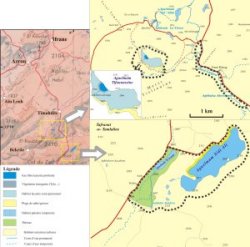 Aguelmams Sidi Ali - Tifounassine. 15/01/05; Ifrane, Khénifra; 600 ha; 33°07'N 005°03'W. Biological and Ecological Reserve, Permanent Hunting Reserve. A complex of three mountain wetlands at 1900-2100m that are fed by snowmelt and springs - they are among the most southernmost representatives of the lacustrine mountain ecosystems of the temperate paleo-arctic bioregion. The wetlands are important wintering sites for migratory birds such as the Ruddy Shelduck (Tadorna ferruginea) and the Crested Coot (Fulica cristata), as well as important sites for the maintenance of invertebrate endemism in the area. Other roles of the site, which is underlain by a karstique system, include its recharge of the groundwater table and provision of a drinking hole for local mammals such as the genet, jackal and Red fox. Activities around the area mainly include livestock raising, followed by tourism, rainbow trout aquaculture and sports fishing, especially in summer. The main threats are water extraction, overgrazing and organic pollution by animal and human use. Different NGOs have undertaken awareness programmes on the ecological, especially ornithological values of the site. Ramsar site no. 1468.
Aguelmams Sidi Ali - Tifounassine. 15/01/05; Ifrane, Khénifra; 600 ha; 33°07'N 005°03'W. Biological and Ecological Reserve, Permanent Hunting Reserve. A complex of three mountain wetlands at 1900-2100m that are fed by snowmelt and springs - they are among the most southernmost representatives of the lacustrine mountain ecosystems of the temperate paleo-arctic bioregion. The wetlands are important wintering sites for migratory birds such as the Ruddy Shelduck (Tadorna ferruginea) and the Crested Coot (Fulica cristata), as well as important sites for the maintenance of invertebrate endemism in the area. Other roles of the site, which is underlain by a karstique system, include its recharge of the groundwater table and provision of a drinking hole for local mammals such as the genet, jackal and Red fox. Activities around the area mainly include livestock raising, followed by tourism, rainbow trout aquaculture and sports fishing, especially in summer. The main threats are water extraction, overgrazing and organic pollution by animal and human use. Different NGOs have undertaken awareness programmes on the ecological, especially ornithological values of the site. Ramsar site no. 1468.
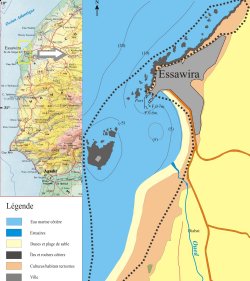 Archipel et dunes d'Essawira. 15/01/05; Essawira; 4,000 ha; 31°30'N 009°48'W. Site of Biological and Ecological Interest, Permanent Biological Reserve, Hunting Reserve. A coastal site composed of sand dunes, the biggest archipelago on Morocco's Atlantic coast, sandy beaches and rocky outcrops. It hosts a number of Macaronesian endemic species, such as the plants Chenolea tomentosa, Polycarpaea nivea and Helianthemum canariense, as well as other rare North African species, including seven endemic reptiles and amphibians. The archipelago constitutes an important stop for migratory species and a nesting site for Eleonora's Falcon, which is represented by 3.5% to 10% of its world population. Thanks to the upwelling, artisanal and professional fishing are very productive activities along the coast. Tourism is also developing, posing potential threats to the site in the future, in addition to poaching and over-fishing. The archipelago is also of archaeological importance due to the presence of Greek, Phoenician and Roman remnants, as well as more recent Portuguese bastions dating to the 17th and 18th centuries. A management plan is currently being developed, together with the set-up of an Environmental Education Centre to act as a biodiversity observatory. Ramsar site no. 1469.
Archipel et dunes d'Essawira. 15/01/05; Essawira; 4,000 ha; 31°30'N 009°48'W. Site of Biological and Ecological Interest, Permanent Biological Reserve, Hunting Reserve. A coastal site composed of sand dunes, the biggest archipelago on Morocco's Atlantic coast, sandy beaches and rocky outcrops. It hosts a number of Macaronesian endemic species, such as the plants Chenolea tomentosa, Polycarpaea nivea and Helianthemum canariense, as well as other rare North African species, including seven endemic reptiles and amphibians. The archipelago constitutes an important stop for migratory species and a nesting site for Eleonora's Falcon, which is represented by 3.5% to 10% of its world population. Thanks to the upwelling, artisanal and professional fishing are very productive activities along the coast. Tourism is also developing, posing potential threats to the site in the future, in addition to poaching and over-fishing. The archipelago is also of archaeological importance due to the presence of Greek, Phoenician and Roman remnants, as well as more recent Portuguese bastions dating to the 17th and 18th centuries. A management plan is currently being developed, together with the set-up of an Environmental Education Centre to act as a biodiversity observatory. Ramsar site no. 1469.
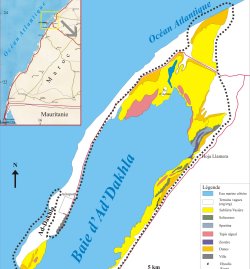 Baie d'Ad-Dakhla; 15/01/05; Ad-Dakhla; 40,000 ha; 23°45'N 015°50'W. A 37km-long bay separated from the ocean by a system of dunes, with a mosaic of habitat types including intertidal seagrass beds, algal plains and salt/sand pans. The site has high botanical diversity, hosting several species which are rare, vulnerable or Macaronesian, Moroccan or Saharan endemics, including the vulnerable dwarf eelgrass Zostera noltii. These form the habitat for more than 120 mollusk species, among which are an endemic crustacean, Cerapopsis takamado, and 41 fish species. This is also the northernmost limit of the Atlantic humpbacked dolphins' distribution and the second most important migratory waterbird wintering site in Morocco, having hosted an average of close to 60,000 birds between 1995 and 2000; among the best-represented species are the Caspian tern, the Lesser Black-backed Gull, and the Great Ringed Plover. Fishing and tourism are important activities, which may pose threats in the future, especially in terms of pollution, if left to develop indiscriminately. A harbour which is being built at 12km from the site may also affect the hydrological and sedimentary balance of the area. No management plan exists as yet, but plans are envisaged to create different exploitation zones in the site, for both conservation and aquaculture purposes. Ramsar site no. 1470.
Baie d'Ad-Dakhla; 15/01/05; Ad-Dakhla; 40,000 ha; 23°45'N 015°50'W. A 37km-long bay separated from the ocean by a system of dunes, with a mosaic of habitat types including intertidal seagrass beds, algal plains and salt/sand pans. The site has high botanical diversity, hosting several species which are rare, vulnerable or Macaronesian, Moroccan or Saharan endemics, including the vulnerable dwarf eelgrass Zostera noltii. These form the habitat for more than 120 mollusk species, among which are an endemic crustacean, Cerapopsis takamado, and 41 fish species. This is also the northernmost limit of the Atlantic humpbacked dolphins' distribution and the second most important migratory waterbird wintering site in Morocco, having hosted an average of close to 60,000 birds between 1995 and 2000; among the best-represented species are the Caspian tern, the Lesser Black-backed Gull, and the Great Ringed Plover. Fishing and tourism are important activities, which may pose threats in the future, especially in terms of pollution, if left to develop indiscriminately. A harbour which is being built at 12km from the site may also affect the hydrological and sedimentary balance of the area. No management plan exists as yet, but plans are envisaged to create different exploitation zones in the site, for both conservation and aquaculture purposes. Ramsar site no. 1470.
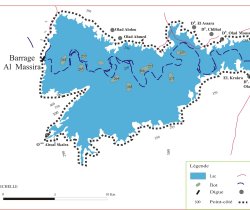 Barrage Al Massira. 15/01/05; Qal'at Essraghna; 14,000 ha; 32°28'N 007°34'W. Site of Biological and Ecological Interest, Permanent Hunting Reserve. The second biggest reservoir in Morocco, it hosts the vulnerable Marbled Teal and constitutes an important wintering site for coots, ducks and geese especially in dry years. In the summer, it also provides refuge to approximately 20 waterbird species, of which 15 build their nests. The reservoir is said to be the only nesting site of the Common Black-headed Gull in Africa, with the presence of 20 breeding pairs. It is considered the most important inland fishing site in Morocco, with seven commonly fished species and catches amounting to 90 tonnes per year. The number of fishing permits is limited to 12 per year. It plays an important role in irrigation of agricultural land and the supply of drinking water, as well as flood control. Its releases during the summer also allow hydropower production further downstream. The main threats to the site are illegal fishing, pollution and disturbance to birds and eggs during the nesting season. Ramsar site no. 1471.
Barrage Al Massira. 15/01/05; Qal'at Essraghna; 14,000 ha; 32°28'N 007°34'W. Site of Biological and Ecological Interest, Permanent Hunting Reserve. The second biggest reservoir in Morocco, it hosts the vulnerable Marbled Teal and constitutes an important wintering site for coots, ducks and geese especially in dry years. In the summer, it also provides refuge to approximately 20 waterbird species, of which 15 build their nests. The reservoir is said to be the only nesting site of the Common Black-headed Gull in Africa, with the presence of 20 breeding pairs. It is considered the most important inland fishing site in Morocco, with seven commonly fished species and catches amounting to 90 tonnes per year. The number of fishing permits is limited to 12 per year. It plays an important role in irrigation of agricultural land and the supply of drinking water, as well as flood control. Its releases during the summer also allow hydropower production further downstream. The main threats to the site are illegal fishing, pollution and disturbance to birds and eggs during the nesting season. Ramsar site no. 1471.
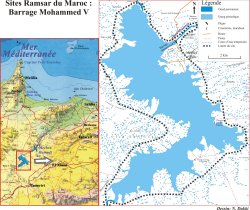 Barrage Mohammed V. 15/01/05; Nador; 5,000 ha; 34°41'N 002°57'W. Site of Biological and Ecological Interest. The site consists of a reservoir from a dam that was built in 1967 on the Moulouya River, situated in an arid valley with several gorges, where the most common plant type is tamarisk, while on the upstream side eucalyptus abounds. The site constitutes an important refuge area for waterfowl in both summer, when members of Fulica atra and Tadorna casarca nest in the area, and winter, when 40 species frequent the site, with an average of more than 25,000 individuals. The reservoir also hosts the east Moroccan endemic barb, Barbus moulouyensis. The site provides the city of Nadur with potable water and allows the irrigation of 60,000 ha of land in the areas of Bou Areg and Triffa. The dam also contributes to hydropower generation and is a fishing site. No significant factors threaten the site. Ramsar site no. 1472.
Barrage Mohammed V. 15/01/05; Nador; 5,000 ha; 34°41'N 002°57'W. Site of Biological and Ecological Interest. The site consists of a reservoir from a dam that was built in 1967 on the Moulouya River, situated in an arid valley with several gorges, where the most common plant type is tamarisk, while on the upstream side eucalyptus abounds. The site constitutes an important refuge area for waterfowl in both summer, when members of Fulica atra and Tadorna casarca nest in the area, and winter, when 40 species frequent the site, with an average of more than 25,000 individuals. The reservoir also hosts the east Moroccan endemic barb, Barbus moulouyensis. The site provides the city of Nadur with potable water and allows the irrigation of 60,000 ha of land in the areas of Bou Areg and Triffa. The dam also contributes to hydropower generation and is a fishing site. No significant factors threaten the site. Ramsar site no. 1472.
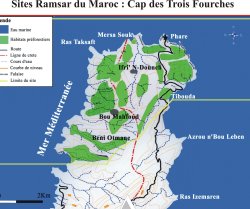 Cap des Trois Fourches. 15/01/05; Nador, 5,000 ha; 35°26'N 002°59'W. Site of Biological and Ecological Interest. A very beautiful site situated at the end of a rocky peninsula in the Mediterranean, composed of cliffs, caves and gravelly beaches, with clear water underlain by a sandy bottom and seagrass beds. The site hosts a number of rare and threatened species, including the monk seal, two species of limpets (Patella ferruginea and Patella nigra), the Loggerhead turtle, the Fin whale and two species of dolphin (Tursiops truncates and Delphinus delphis). The water quality is very good thanks to a particular phenomenon of sea currents which ensures that pollution from the nearby cities is transported away from the promontory. The main activities taking place in the area are fishing and tourism, which also constitute, although still at a small scale, the main threats to the site, including construction of tourism facilities, dynamite fishing, pollution by solid waste, and disturbance of local fauna. There are plans to declare the area a permanent biological reserve for the monk seal. The MedWetCoast programme has also proposed some conservation and management measures which still need to be implemented. Ramsar site no. 1473.
Cap des Trois Fourches. 15/01/05; Nador, 5,000 ha; 35°26'N 002°59'W. Site of Biological and Ecological Interest. A very beautiful site situated at the end of a rocky peninsula in the Mediterranean, composed of cliffs, caves and gravelly beaches, with clear water underlain by a sandy bottom and seagrass beds. The site hosts a number of rare and threatened species, including the monk seal, two species of limpets (Patella ferruginea and Patella nigra), the Loggerhead turtle, the Fin whale and two species of dolphin (Tursiops truncates and Delphinus delphis). The water quality is very good thanks to a particular phenomenon of sea currents which ensures that pollution from the nearby cities is transported away from the promontory. The main activities taking place in the area are fishing and tourism, which also constitute, although still at a small scale, the main threats to the site, including construction of tourism facilities, dynamite fishing, pollution by solid waste, and disturbance of local fauna. There are plans to declare the area a permanent biological reserve for the monk seal. The MedWetCoast programme has also proposed some conservation and management measures which still need to be implemented. Ramsar site no. 1473.
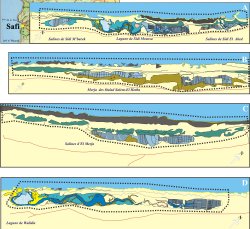 Complexe de Sidi Moussa-Walidia. 15/01/05; Al Jadida; 10,000 ha, 32°54'N 008°49'W. Site of Biological and Ecological Interest, Permanent Hunting Reserve, Zones d'Intérêt pour la Conservation des Oiseaux au Maroc. The site consists of two lagoons, four swamps, salines and salt marshes that are separated from the sea and a sandy beach by a system of sand dunes. Most waterbird species that migrate the east-Atlantic route pass this site and more than 3% of birds that winter in Morocco choose this wetland complex, including the two endangered species Marbled Teal and Eurasian spoonbill. This area also forms the southern distribution limit of an endemic Moroccan amphibian, Pelobates varaldii. The main human activities include agriculture and livestock raising, but salt is also exploited and the Japanese oyster is cultivated in one of the lagoons. Excessive use of pesticides and fertilizers is causing groundwater contamination, while water extraction for irrigation has caused the wetlands' surface area to decrease by 21% between 1957 and 1991. The transformation of wetlands into saltworks, although benefiting the waders, has reduced flora and fauna biodiversity, especially of invertebrates. Disturbance to birds by different anthropogenic factors is also a cause of concern. A management plan is proposed for the future. Ramsar site no. 1474.
Complexe de Sidi Moussa-Walidia. 15/01/05; Al Jadida; 10,000 ha, 32°54'N 008°49'W. Site of Biological and Ecological Interest, Permanent Hunting Reserve, Zones d'Intérêt pour la Conservation des Oiseaux au Maroc. The site consists of two lagoons, four swamps, salines and salt marshes that are separated from the sea and a sandy beach by a system of sand dunes. Most waterbird species that migrate the east-Atlantic route pass this site and more than 3% of birds that winter in Morocco choose this wetland complex, including the two endangered species Marbled Teal and Eurasian spoonbill. This area also forms the southern distribution limit of an endemic Moroccan amphibian, Pelobates varaldii. The main human activities include agriculture and livestock raising, but salt is also exploited and the Japanese oyster is cultivated in one of the lagoons. Excessive use of pesticides and fertilizers is causing groundwater contamination, while water extraction for irrigation has caused the wetlands' surface area to decrease by 21% between 1957 and 1991. The transformation of wetlands into saltworks, although benefiting the waders, has reduced flora and fauna biodiversity, especially of invertebrates. Disturbance to birds by different anthropogenic factors is also a cause of concern. A management plan is proposed for the future. Ramsar site no. 1474.
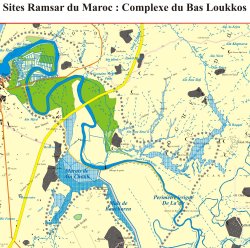 Complexe du bas Loukkos. 15/01/05; Larache; 3,600 ha; 35°07'N 006°00'W. Site of Biological and Ecological Interest, Zones d'Intérêt pour la Conservation des Oiseaux au Maroc. A unique complex of wetland types on Morocco's Atlantic coastline, including estuarine waters, shallow marine waters, salt steppes, freshwater swamps and floodplains, in addition to rice paddies in drained areas and a number of abandoned salines. It hosts a number of vulnerable or near-threatened species at the international scale, such as the Marbled Teal (Marmaronetta angustirostris) and the Ferruginous duck (Aythya nyroca), as well as at the national scale, including among others the Squacco and Purple Herons, the Red-crested Pochard and the Marsh Owl. The site also presents large water lily and Salix expanses, rare for Morocco, and plays an important role in groundwater recharge and flood control. The main activities around the site are agriculture, livestock raising, salt production, and tourism. These are also the main causes of eutrophication, water diversion upstream, and dredging of some areas for further agricultural development. The "Déclaration de Larache 2002" is a project in the pipeline which involves eight governmental and non-governmental partners in contributing to the conservation and sustainable development of this site. Ramsar site no. 1475.
Complexe du bas Loukkos. 15/01/05; Larache; 3,600 ha; 35°07'N 006°00'W. Site of Biological and Ecological Interest, Zones d'Intérêt pour la Conservation des Oiseaux au Maroc. A unique complex of wetland types on Morocco's Atlantic coastline, including estuarine waters, shallow marine waters, salt steppes, freshwater swamps and floodplains, in addition to rice paddies in drained areas and a number of abandoned salines. It hosts a number of vulnerable or near-threatened species at the international scale, such as the Marbled Teal (Marmaronetta angustirostris) and the Ferruginous duck (Aythya nyroca), as well as at the national scale, including among others the Squacco and Purple Herons, the Red-crested Pochard and the Marsh Owl. The site also presents large water lily and Salix expanses, rare for Morocco, and plays an important role in groundwater recharge and flood control. The main activities around the site are agriculture, livestock raising, salt production, and tourism. These are also the main causes of eutrophication, water diversion upstream, and dredging of some areas for further agricultural development. The "Déclaration de Larache 2002" is a project in the pipeline which involves eight governmental and non-governmental partners in contributing to the conservation and sustainable development of this site. Ramsar site no. 1475.
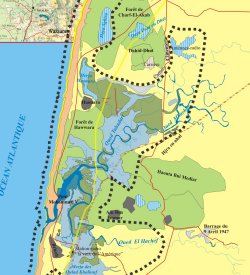 Complexe du bas Tahaddart. 15/01/05; Tanger; 11,000 ha; 35°34'N 006°00'W. Site of Biological and Ecological Interest. A complex of wetland types (including brackish and freshwater marshes and pools, subtidal aquatic beds, sand dunes, etc.) which are fed by the tides and precipitation. Especially during particularly wet years, they are an important stop for migratory species such as the Greater flamingo and Common crane, as the wetlands constitute the last feeding stop before the Gibraltar Strait, on the way to and from Europe. The complex also hosts the vulnerable Great Bustard (Otis tarda), whose population is localized and threatened and said to be the only one present in Africa. The area's hydrology and landscape has been negatively affected by developments including roads and railway lines, abandoned salt works, but especially the radio station "The Voice of America" and its access roads, which have replaced a large salt steppe and a part of the lake of Wlad Khallouf. The soils in the area are very fertile thanks to the sediments deposited by floods, but they are today becoming over-exploited, as sediments in floodwaters have decreased due to trapping by upstream dams. Thus agriculture is common, as well as livestock raising, tourism, tuna fishing and sand extraction for construction purposes. An archaeological site has recently been discovered, which is expected to increase the site's cultural value. Ramsar site no. 1476.
Complexe du bas Tahaddart. 15/01/05; Tanger; 11,000 ha; 35°34'N 006°00'W. Site of Biological and Ecological Interest. A complex of wetland types (including brackish and freshwater marshes and pools, subtidal aquatic beds, sand dunes, etc.) which are fed by the tides and precipitation. Especially during particularly wet years, they are an important stop for migratory species such as the Greater flamingo and Common crane, as the wetlands constitute the last feeding stop before the Gibraltar Strait, on the way to and from Europe. The complex also hosts the vulnerable Great Bustard (Otis tarda), whose population is localized and threatened and said to be the only one present in Africa. The area's hydrology and landscape has been negatively affected by developments including roads and railway lines, abandoned salt works, but especially the radio station "The Voice of America" and its access roads, which have replaced a large salt steppe and a part of the lake of Wlad Khallouf. The soils in the area are very fertile thanks to the sediments deposited by floods, but they are today becoming over-exploited, as sediments in floodwaters have decreased due to trapping by upstream dams. Thus agriculture is common, as well as livestock raising, tourism, tuna fishing and sand extraction for construction purposes. An archaeological site has recently been discovered, which is expected to increase the site's cultural value. Ramsar site no. 1476.
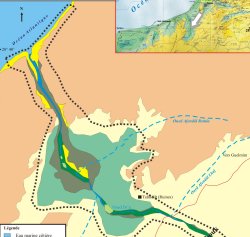 Embouchure de l'oued Dr'a. 15/01/05; Guelmim; 10,000 ha; 28°34'N 010°58'W. Site of Biological and Ecological Interest. The estuary of the Dr'a River, which is situated on the northern limit of the Sahara and runs among bushy dunes until it reaches the sea through a gorge. The landscape is composed of three main vegetation types, the Tamarix amplexicaule complex, Phragmites stands, and a salt steppe with Sarcocornia perennis, which serve as a refuge for many European migratory bird species, including the Marbled Teal (Marmaronetta angustirostris), flamingoes (Phoenicopterus ruber) and the North African Cormorant (Phalacrocorax carbo maroccanus). Different endemic and relict species are found at the site, such as a tropical fish relict, Tilapia zillii, different reptile species, an amphibian (Bufo brongersmai), and two mammals (Tarfaya shrew and the Occidental gerbil). Fishing is common at the site, as well as raising of sheep, camels and goats, and limited barley agriculture. The main threats include rife poaching (despite the fact that hunting is prohibited), waste from the fishing camps, and disturbance to the environment by 4x4 vehicles. There are plans to create a national park in the area. Ramsar site no. 1477.
Embouchure de l'oued Dr'a. 15/01/05; Guelmim; 10,000 ha; 28°34'N 010°58'W. Site of Biological and Ecological Interest. The estuary of the Dr'a River, which is situated on the northern limit of the Sahara and runs among bushy dunes until it reaches the sea through a gorge. The landscape is composed of three main vegetation types, the Tamarix amplexicaule complex, Phragmites stands, and a salt steppe with Sarcocornia perennis, which serve as a refuge for many European migratory bird species, including the Marbled Teal (Marmaronetta angustirostris), flamingoes (Phoenicopterus ruber) and the North African Cormorant (Phalacrocorax carbo maroccanus). Different endemic and relict species are found at the site, such as a tropical fish relict, Tilapia zillii, different reptile species, an amphibian (Bufo brongersmai), and two mammals (Tarfaya shrew and the Occidental gerbil). Fishing is common at the site, as well as raising of sheep, camels and goats, and limited barley agriculture. The main threats include rife poaching (despite the fact that hunting is prohibited), waste from the fishing camps, and disturbance to the environment by 4x4 vehicles. There are plans to create a national park in the area. Ramsar site no. 1477.
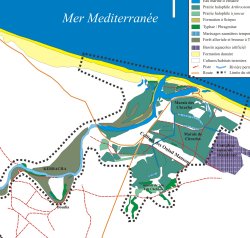 Embouchure de la Moulouya. 15/01/05; Berkane; 3,000 ha; 35°04'N 002°23'W. The most significant estuary and floodplain complex of Maghreb's biggest Mediterranean river, this site comprises five systems: marine, estuarine, lacustrine, riverine and palustrine, in addition to the coastal dunes. It is a compulsory stop, given the surroundings' aridity, for European migrants that find refuge in the Tamarix vegetation system. These include Moussier's Redstart (Phoenicurus moussieri), the Marbled Teal (Marmaronetta angustirostris), and Audouin's Gull (Larus audouinii). Some endemic and rare fish can also be found in the wetlands, which are utilized as spawning and growing grounds during migrations. The site is also important in its storage of floodwaters, which contribute to lowering the groundwater's salinity levels. This area has a high aesthetic value and ecotourism potential. An area of the estuary is dedicated to the culture of juvenile eels, while there are abandoned agricultural fields and pastoral activities taking place in some parts of the estuary. The main threats include wetland habitat loss (by sand and gravel quarries, which have destroyed riverbanks and the Tamarix habitat); transformation of natural habitats into aquaculture ponds; modifications of the hydrological balance and water quality due to agriculture, aquaculture, solid waste and decrease in flood flows; loss of biodiversity and aesthetic value. Ramsar site no. 1478.
Embouchure de la Moulouya. 15/01/05; Berkane; 3,000 ha; 35°04'N 002°23'W. The most significant estuary and floodplain complex of Maghreb's biggest Mediterranean river, this site comprises five systems: marine, estuarine, lacustrine, riverine and palustrine, in addition to the coastal dunes. It is a compulsory stop, given the surroundings' aridity, for European migrants that find refuge in the Tamarix vegetation system. These include Moussier's Redstart (Phoenicurus moussieri), the Marbled Teal (Marmaronetta angustirostris), and Audouin's Gull (Larus audouinii). Some endemic and rare fish can also be found in the wetlands, which are utilized as spawning and growing grounds during migrations. The site is also important in its storage of floodwaters, which contribute to lowering the groundwater's salinity levels. This area has a high aesthetic value and ecotourism potential. An area of the estuary is dedicated to the culture of juvenile eels, while there are abandoned agricultural fields and pastoral activities taking place in some parts of the estuary. The main threats include wetland habitat loss (by sand and gravel quarries, which have destroyed riverbanks and the Tamarix habitat); transformation of natural habitats into aquaculture ponds; modifications of the hydrological balance and water quality due to agriculture, aquaculture, solid waste and decrease in flood flows; loss of biodiversity and aesthetic value. Ramsar site no. 1478.
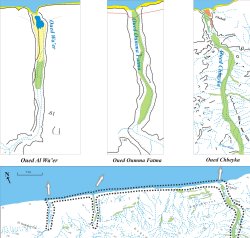 Embouchures des oueds Chbeyka-Al Wa'er. 15/01/05; Tan Tan; 8,000 ha; 28°14'N 011°42'W. The estuaries of three temporary rivers that arise in the Moyen Atlas mountain range and run through deep gorges before reaching the coast, where one can find sandy beaches, cliffs and dunes. Salt steppes with the endangered Sarcocornia perennis plant species in the upstream area of the site, where the rivers are wider, act as an important refuge for migratory birds, among which the most significant are the Lesser Black-backed Gull (Larus fuscus), Audouin's Gull (Larus audouinii), and the Common Scoter (Melanitta nigra). Fishing camps are common in the area, as the waters are rich thanks to upwelling, while tourism is also on the increase due to the area's beauty. Both activities are a cause of disturbance to the birds and of solid waste pollution. The area has been proposed as a Site of Biological and Ecological Interest. Ramsar site no. 1479.
Embouchures des oueds Chbeyka-Al Wa'er. 15/01/05; Tan Tan; 8,000 ha; 28°14'N 011°42'W. The estuaries of three temporary rivers that arise in the Moyen Atlas mountain range and run through deep gorges before reaching the coast, where one can find sandy beaches, cliffs and dunes. Salt steppes with the endangered Sarcocornia perennis plant species in the upstream area of the site, where the rivers are wider, act as an important refuge for migratory birds, among which the most significant are the Lesser Black-backed Gull (Larus fuscus), Audouin's Gull (Larus audouinii), and the Common Scoter (Melanitta nigra). Fishing camps are common in the area, as the waters are rich thanks to upwelling, while tourism is also on the increase due to the area's beauty. Both activities are a cause of disturbance to the birds and of solid waste pollution. The area has been proposed as a Site of Biological and Ecological Interest. Ramsar site no. 1479.
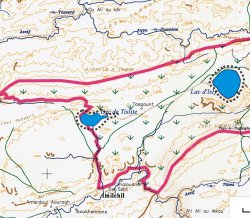 Lacs Isly-Tislite. 15/01/05; Errachidia; 800 ha; 32°13'N 005°35'W. Parc National du Haut Atlas Oriental, Site of Biological and Ecological Interest. Lakes Isly and Tislite are the second and third highest lakes in North Africa, at 2270m and 2225m respectively, situated in the Haute Atlas mountain range. They are unique because of their great depth; the fact they are two of only three Moroccan lakes that are not eutrophic; their karstic or pseudo-karstic origin; and their situation at the southern limit of the paleo-arctic region. They also host an autochthonous phenotype of brown trout Salmo trutta macrostigma. The vegetation in the area is steppic and snowmelt feeds the lakes. The lakes are important for recharging the groundwater table, while in their surroundings animal grazing is common, as well as sport fishing during summer. The main threats include illegal fishing, overgrazing and organic pollution by livestock and by using the lakes for washing purposes. In order to increase awareness on the ecological values of the site, a local association, ADRAR, is currently undertaking a research and information-sharing project financed by GEF, which is aimed at preserving biodiversity and the wise use of the natural resources in the area.
Lacs Isly-Tislite. 15/01/05; Errachidia; 800 ha; 32°13'N 005°35'W. Parc National du Haut Atlas Oriental, Site of Biological and Ecological Interest. Lakes Isly and Tislite are the second and third highest lakes in North Africa, at 2270m and 2225m respectively, situated in the Haute Atlas mountain range. They are unique because of their great depth; the fact they are two of only three Moroccan lakes that are not eutrophic; their karstic or pseudo-karstic origin; and their situation at the southern limit of the paleo-arctic region. They also host an autochthonous phenotype of brown trout Salmo trutta macrostigma. The vegetation in the area is steppic and snowmelt feeds the lakes. The lakes are important for recharging the groundwater table, while in their surroundings animal grazing is common, as well as sport fishing during summer. The main threats include illegal fishing, overgrazing and organic pollution by livestock and by using the lakes for washing purposes. In order to increase awareness on the ecological values of the site, a local association, ADRAR, is currently undertaking a research and information-sharing project financed by GEF, which is aimed at preserving biodiversity and the wise use of the natural resources in the area.
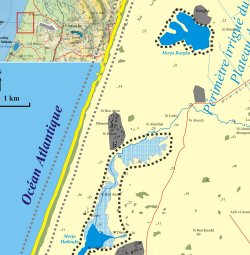 Marais et côte du Plateau de Rmel. 15/01/05; Kénitra, Larache, 1,300 ha; 35°02'N 006°14'W. Zones d'importance pour la Conservation des Oiseaux, Site of Biological and Ecological Interest. A complex of three freshwater coastal lakes, the adjacent sandy beach and coastline, inter-dunal marshes, and irrigated areas. It hosts a number of endangered species such as the Marbled Teal (Marmaronetta angustirostris), Audouin's Gull (Larus audouinii), the Ferruginous Duck (Aythya nyroca) and the Common Otter (Lutra lutra), in addition to three endemic reptiles and an endemic amphibian. It is also an important wintering site for the Lesser Black-backed Gull, hosting on average more than 1% of its biogeographical population. The site has a high agricultural potential, due to the soil's fertility and availability of irrigation facilities, and fishing potential, especially of eels (Anguilla anguilla) and elvers. Birdwatching trips and hunting take place in the area as well. The main problems and threats are related to agriculture, ranging from lowering of the groundwater table to reduction in river flows, eutrophication, and pollution due to pesticide and fertilizer use. Ramsar site no. 1481.
Marais et côte du Plateau de Rmel. 15/01/05; Kénitra, Larache, 1,300 ha; 35°02'N 006°14'W. Zones d'importance pour la Conservation des Oiseaux, Site of Biological and Ecological Interest. A complex of three freshwater coastal lakes, the adjacent sandy beach and coastline, inter-dunal marshes, and irrigated areas. It hosts a number of endangered species such as the Marbled Teal (Marmaronetta angustirostris), Audouin's Gull (Larus audouinii), the Ferruginous Duck (Aythya nyroca) and the Common Otter (Lutra lutra), in addition to three endemic reptiles and an endemic amphibian. It is also an important wintering site for the Lesser Black-backed Gull, hosting on average more than 1% of its biogeographical population. The site has a high agricultural potential, due to the soil's fertility and availability of irrigation facilities, and fishing potential, especially of eels (Anguilla anguilla) and elvers. Birdwatching trips and hunting take place in the area as well. The main problems and threats are related to agriculture, ranging from lowering of the groundwater table to reduction in river flows, eutrophication, and pollution due to pesticide and fertilizer use. Ramsar site no. 1481.
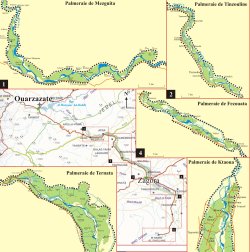 Moyenne Dr'a. 15/01/05; Ouarzazate, Zagora; 45,000 ha, 30°29'N 006°21'W. Site of Biological and Ecological Interest, Permanent Hunting Reserve. The site is composed of six units within two artificial habitats: the reservoir of the Al Mansour Ad-Dahbi dam, situated just downstream of the confluence of two rivers, and six oases with irrigated palm plantations along the course of the Dr'a River. More than 20 bird species winter or nest in the area of the dam, while about 100 other bird species rely on the oases' palm plantations. The site is an important refuge for migratory species, especially sparrows on the Trans-Saharan route, which utilize this site for resting before and after crossing the desert. Common mammals in the area, some of which are rare in Morocco, include the Fennec Fox, the North African striped weasel, African wildcat, the Common Genet and Common Otter. Several reptile species increase the area's biodiversity, together with the genetic resources associated with the date palms and other cultures in the area. The main services of the site fishing in the reservoir, hydropower, provision of drinking water supply, and water extraction for agriculture (palm and fruit trees, henna, cereals). The area has been deeply affected by the agricultural developments in the area and excessive water extraction, which have caused a fall in riparian biodiversity. Ramsar site no. 1482.
Moyenne Dr'a. 15/01/05; Ouarzazate, Zagora; 45,000 ha, 30°29'N 006°21'W. Site of Biological and Ecological Interest, Permanent Hunting Reserve. The site is composed of six units within two artificial habitats: the reservoir of the Al Mansour Ad-Dahbi dam, situated just downstream of the confluence of two rivers, and six oases with irrigated palm plantations along the course of the Dr'a River. More than 20 bird species winter or nest in the area of the dam, while about 100 other bird species rely on the oases' palm plantations. The site is an important refuge for migratory species, especially sparrows on the Trans-Saharan route, which utilize this site for resting before and after crossing the desert. Common mammals in the area, some of which are rare in Morocco, include the Fennec Fox, the North African striped weasel, African wildcat, the Common Genet and Common Otter. Several reptile species increase the area's biodiversity, together with the genetic resources associated with the date palms and other cultures in the area. The main services of the site fishing in the reservoir, hydropower, provision of drinking water supply, and water extraction for agriculture (palm and fruit trees, henna, cereals). The area has been deeply affected by the agricultural developments in the area and excessive water extraction, which have caused a fall in riparian biodiversity. Ramsar site no. 1482.
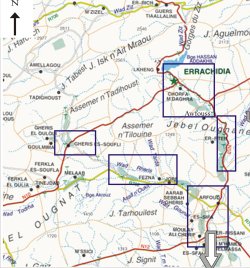 Oasis du Tafilalet. 15/01/05; Errachidia, Goulmima; 65,000 ha; 31°17'N 004°15'W. Part of UNESCO Biosphere Reserve, Site of Biological and Ecological Interest. This site comprises a series of oases, the reservoir of one of the oldest dams in Morocco (Hassan Ad-Dakhil), small rivers, irrigation channels, and lacustrine and marsh areas. It is an important wintering site for migratory birds, especially sparrows and two endangered waterbird species, Tadorna ferruginea and Marmaronetta angustirostris. It also hosts remarkable populations of Ruppell's Bat (Pipistrellus rueppelli) and of the Sand Cat (Felis margarita), in addition to an endemic fish (Barbus figuiguensis). Agriculture is a common activity, with the main cultivation being alfalfa, cereals, henna, date palms and fruit trees. Sheep raising is also common, with the D'man race showing the best productivity rates. The dam's control of downstream water releases has meant that many river channels downstream only have water during certain times of the year, a phenomenon which is worsened by excessive water abstraction for agriculture and human consumption and the droughts that have become more common during the past two decades. Soil salinisation has also become a problem in many areas, due to the high rates of evaporation. Ramsar site no. 1483.
Oasis du Tafilalet. 15/01/05; Errachidia, Goulmima; 65,000 ha; 31°17'N 004°15'W. Part of UNESCO Biosphere Reserve, Site of Biological and Ecological Interest. This site comprises a series of oases, the reservoir of one of the oldest dams in Morocco (Hassan Ad-Dakhil), small rivers, irrigation channels, and lacustrine and marsh areas. It is an important wintering site for migratory birds, especially sparrows and two endangered waterbird species, Tadorna ferruginea and Marmaronetta angustirostris. It also hosts remarkable populations of Ruppell's Bat (Pipistrellus rueppelli) and of the Sand Cat (Felis margarita), in addition to an endemic fish (Barbus figuiguensis). Agriculture is a common activity, with the main cultivation being alfalfa, cereals, henna, date palms and fruit trees. Sheep raising is also common, with the D'man race showing the best productivity rates. The dam's control of downstream water releases has meant that many river channels downstream only have water during certain times of the year, a phenomenon which is worsened by excessive water abstraction for agriculture and human consumption and the droughts that have become more common during the past two decades. Soil salinisation has also become a problem in many areas, due to the high rates of evaporation. Ramsar site no. 1483.
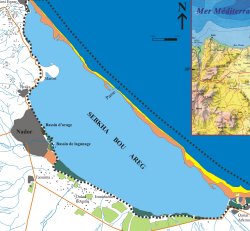 Sebkha Bou Areg. 15/01/05; Nador; 14,000 ha; 35°10'N 002°51'W. The largest lagoon on the Mediterranean southern shore, with a length of 24km and a width of 7.5km, separated by the sea by a system of sand dunes. It is a micro-tidal lagoon system with high biodiversity levels and acts as a wintering site for migratory birds, and as spawning and feeding ground for several fish species. Among the variety of life forms, one can find 13 fish species, nine mollusks, two cephalopods and two crustaceans. Bird species which nest here include the Water Rail, the Little Tern, the Pied Avocet and the Slender-billed Gull. Agriculture, fishing and salt production are the main activities to be found. Aquaculture is also practiced by the Moroccan Society for Ostreiculture (MAROST) and concentrates among others on the royal sea-bream, Japanese shrimp, and two oyster varieties. The main threats to the site are pollution by the activities taking place in the surroundings. Conservation measures are being proposed but none are in place thus far. Ramsar site no. 1484.
Sebkha Bou Areg. 15/01/05; Nador; 14,000 ha; 35°10'N 002°51'W. The largest lagoon on the Mediterranean southern shore, with a length of 24km and a width of 7.5km, separated by the sea by a system of sand dunes. It is a micro-tidal lagoon system with high biodiversity levels and acts as a wintering site for migratory birds, and as spawning and feeding ground for several fish species. Among the variety of life forms, one can find 13 fish species, nine mollusks, two cephalopods and two crustaceans. Bird species which nest here include the Water Rail, the Little Tern, the Pied Avocet and the Slender-billed Gull. Agriculture, fishing and salt production are the main activities to be found. Aquaculture is also practiced by the Moroccan Society for Ostreiculture (MAROST) and concentrates among others on the royal sea-bream, Japanese shrimp, and two oyster varieties. The main threats to the site are pollution by the activities taking place in the surroundings. Conservation measures are being proposed but none are in place thus far. Ramsar site no. 1484.
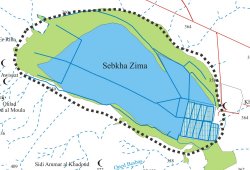 Sebkha Zima. 15/01/05; Safi; 760 ha; 32°05'N 008°40'W. An endorheic lake with saline water, which supports a number of organisms adapted to hypersaline conditions, including two rare endemic plant species (Halopelis amplicauli and Spergularia tenuifolia), 46 phytoplankton and 11 zooplankton species. It also has a high ornithological value, supporting a number of species during both winter and reproduction seasons. These include significant proportions of the biogeographical populations of Marmaronetta angustirostris, Tadorna ferruginea and Phoenicopterus ruber. The site plays an important role in the recharge of the groundwater table. 30,000 tonnes of salt are produced annually from this area, supplying salt to the cities of Marrakech and Safi and providing employment to 50 people. However, salt extraction has transformed almost half of the wetland area into salt works and drainage channels and deeply modified the site's hydrology. Overgrazing, cutting of firewood, and disturbance to birds and nests are also a concern. No conservation measures exist at the moment, but some are being proposed for the future, such as preventing any further habitat transformation and closing certain areas during the bird reproduction period. Ramsar site no. 1485.
Sebkha Zima. 15/01/05; Safi; 760 ha; 32°05'N 008°40'W. An endorheic lake with saline water, which supports a number of organisms adapted to hypersaline conditions, including two rare endemic plant species (Halopelis amplicauli and Spergularia tenuifolia), 46 phytoplankton and 11 zooplankton species. It also has a high ornithological value, supporting a number of species during both winter and reproduction seasons. These include significant proportions of the biogeographical populations of Marmaronetta angustirostris, Tadorna ferruginea and Phoenicopterus ruber. The site plays an important role in the recharge of the groundwater table. 30,000 tonnes of salt are produced annually from this area, supplying salt to the cities of Marrakech and Safi and providing employment to 50 people. However, salt extraction has transformed almost half of the wetland area into salt works and drainage channels and deeply modified the site's hydrology. Overgrazing, cutting of firewood, and disturbance to birds and nests are also a concern. No conservation measures exist at the moment, but some are being proposed for the future, such as preventing any further habitat transformation and closing certain areas during the bird reproduction period. Ramsar site no. 1485.
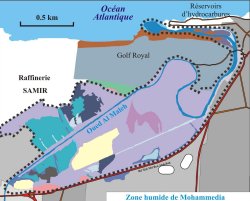 Zones humides de l'oued El Maleh. 15/01/05; Mohammedia; 1,200 ha, 33°39'N 007°23'W. Site of Biological and Ecological Interest. A wetland complex made up of two separate systems: a littoral swamp and salt steppe which correspond to the estuary of the Al Maleh River, and a small reservoir situated 30km upstream. This site is an important refuge during migrations and for wintering for a variety of 80 bird species, ranging from waterbirds to sparrows and birds of prey. The dam has been crucial in promoting the development of agriculture and fishing in the region, which are the main activities carried out, in addition to playing an important role in the control of floods. Its water volume has been reduced, however, due to sedimentation and this, combined with the canalization in parts of the estuary of the river, has meant that many floods still have destructive effects. The estuary of the Al Maleh is also used for educational purposes for schoolchildren from the nearby city of Mohammedia in order to raise awareness of environmental protection. Pollution by several industries (chemical, mechanical and electrical) which surround the site poses the main threat, together with the construction of canals which have altered the site's hydrology. Ramsar site no. 1486.
Zones humides de l'oued El Maleh. 15/01/05; Mohammedia; 1,200 ha, 33°39'N 007°23'W. Site of Biological and Ecological Interest. A wetland complex made up of two separate systems: a littoral swamp and salt steppe which correspond to the estuary of the Al Maleh River, and a small reservoir situated 30km upstream. This site is an important refuge during migrations and for wintering for a variety of 80 bird species, ranging from waterbirds to sparrows and birds of prey. The dam has been crucial in promoting the development of agriculture and fishing in the region, which are the main activities carried out, in addition to playing an important role in the control of floods. Its water volume has been reduced, however, due to sedimentation and this, combined with the canalization in parts of the estuary of the river, has meant that many floods still have destructive effects. The estuary of the Al Maleh is also used for educational purposes for schoolchildren from the nearby city of Mohammedia in order to raise awareness of environmental protection. Pollution by several industries (chemical, mechanical and electrical) which surround the site poses the main threat, together with the construction of canals which have altered the site's hydrology. Ramsar site no. 1486.
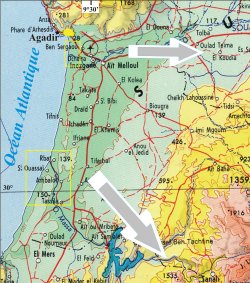 Zones humides de Souss-Massa. 15/01/05; Agadir; 1,000 ha; 30°13'N 009°37'W. Parc National de Souss-Massa, Permanent Hunting Reserve. Two two separate areas which are part of a national park that was initially designated to protect the critically endangered Northern Bald Ibis (Geronticus eremita), which is represented by 7% of its biogeographic population. Subsequently, it was found that more than 270 bird species occur in the area, with several finding refuge at the site during winter, including the Marbled Teal, the Greater Flamingo, the Caspian Tern and the Little Tern. The area comprises a variety of habitats, ranging from dunes to freshwater and brackish marshes, coastal waters, sandy beaches and rocky shores. The main activities taking place in the site are agricultural, with a large area dedicated to banana plantations and livestock raising, as well as ecotourism and tourism along the coast. Threats include urban pollution and disturbance to the fauna by locals and tourists. Ramsar site no. 1487.
Zones humides de Souss-Massa. 15/01/05; Agadir; 1,000 ha; 30°13'N 009°37'W. Parc National de Souss-Massa, Permanent Hunting Reserve. Two two separate areas which are part of a national park that was initially designated to protect the critically endangered Northern Bald Ibis (Geronticus eremita), which is represented by 7% of its biogeographic population. Subsequently, it was found that more than 270 bird species occur in the area, with several finding refuge at the site during winter, including the Marbled Teal, the Greater Flamingo, the Caspian Tern and the Little Tern. The area comprises a variety of habitats, ranging from dunes to freshwater and brackish marshes, coastal waters, sandy beaches and rocky shores. The main activities taking place in the site are agricultural, with a large area dedicated to banana plantations and livestock raising, as well as ecotourism and tourism along the coast. Threats include urban pollution and disturbance to the fauna by locals and tourists. Ramsar site no. 1487.